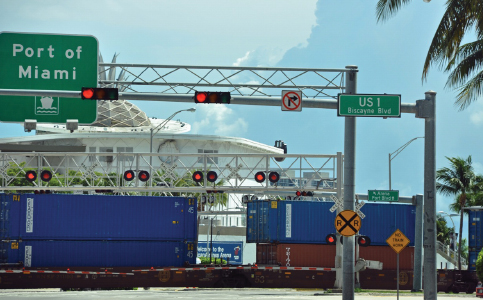Port Miami sees 3% rise in rail cargo

Rail cargo volume at PortMiami has decreased slightly during the 2022 fiscal year, although it’s still the second largest ever recorded, trailing only last year.
For the 2022 fiscal year, beginning October 2021 and ending in September, Florida East Coast Railway cargo volumes at PortMiami have slightly decreased by 1.2% from last year. Despite the decrease, this year’s volumes were the second largest ever recorded at PortMiami, said Alfredo Pereira, public affairs, marketing and communications officer at PortMiami, in a written statement.
“This is a general trend we are seeing as imports start to level off the peaks, we saw in 2021, and we start seeing some decreases when compared to that year, but when compared to 2020 and previous years, we are still significantly higher,” he said in a statement.
Last year, PortMiami recorded an all-time-high performance record of 1,254,062 TEUs (20-foot equivalent units, a standard measure of cargo), Miami Today reported in June. The port also said to be expecting a 3% increase in cargo year over year.
“We are seeing a slightly different narrative,” said the PortMiami spokesperson in a written statement. “Cargo volumes have slowed down following the surge of demand caused by the pandemic. We expect volumes to continue increasing throughout [the 2023 fiscal year] with the possible addition of new services from various ocean carriers.”
With PortMiami’s newest infrastructure developments, including the deepening of the main cargo channel to accommodate super-sized vessels; new super post-Panamax gantry cranes with a capacity of 10,000 TEUs, a lift capacity of 100 tons and outreach of 223 feet; and a $50 million investment in the modernization of its on-dock freight rail system, “we can accommodate cargo more efficiently,” said Mr. Pereira.
In August, the US Department of Transportation announced that PortMiami would receive a $16 million Rebuilding American Infrastructure with Sustainability and Equity (RAISE) grant for its NetZero: Cargo Mobility Optimization and Resiliency Project, according to a press release by Miami-Dade County.
“[This grant] will be used to finance the expansion of our rail service at PortMiami by going from two tracks to five tracks to accommodate for more trains and cargo on-port,” said Mr. Pereira. “We aim to grow our rail capacity from the current 5% of our total to 20% in the near future.”
Florida East Coast (FEC) Railways have been moving one to two trains a day at PortMiami, depending on the volume of containers that need to be moved from the port daily. Each train brings about 60 to 80 containers into PortMiami from the US inland, according to a statement from PortMiami.
Every outgoing train takes 50 to 60 containers into Central and North Florida and the Southeastern U.S.
Cotton is one of the main products being hauled by rail to PortMiami from Charlotte, NC, to be exported to Central America, where it will be used to make different assortments of apparel, according to PortMiami. That same apparel is then shipped back to Miami and transported by a FEC rail to the Southeast and Northeast of the United States.
Another major product that is used and transported routinely by FEC rail is garlic, coming into PortMiami and shipped to Central and North Florida and other distribution areas.
A lot of FEC railways haulage is also general cargo, including retail goods, electronics, white goods – such as refrigerators and washing machines, usually in the color white – furniture, building materials and houseware.
“A recent surge in demand for furniture and similar products has seen importers using FEC rail to transport their products to distribution centers around Florida and in the Southeast United States,” said Mr. Pereira in a statement. “Our dedicated FEC rail services include routes from PortMiami to Jacksonville, Charlotte, and Tampa. FECR also has a direct service to Quality Container Yard’s inland port for local distribution. Jacksonville and Charlotte are the dominant routes for (container transportation and shipping companies) CMA CGM and Seaboard Marine.”
CMA CGM is starting to get volumes from Jacksonville’s new Mediterranean service where PortMiami is the first port of call, said Mr. Pereira.
When it comes to the nearshoring initiative targeting Latin America and the Caribbean, where a lot of the manufacturing that his0torically took place in Asia is taken closer to the Western Hemisphere, “we have seen many businesses move manufacturing to Mexico.”
City Furniture moved operations from Asia to Puebla, Mexico. PortMiami has also seen more production of perishables coming from Latin America and the Caribbean. USDA estimates that by 2027, 75% of all fruit and 50% of all vegetables consumed in the United States will be imported though Mexico by LATAM Airlines.
“In the near future, we expect continued growth especially from imports, as the South Florida region continues to grow in population and in general demand,” said Mr. Pereira in a written statement. “We expect consumption to fuel an increase in demand for perishables, apparel, and housing materials to fulfill a booming population.”
PortMiami additionally expects additional yard improvements to increase capacity and cargo handling under the federal Infrastructure Investment and Jobs Act, where $17 billion will be allocated for ports and waterways.
The port also expects more ships due to congestion in other ports, as ocean carriers look for ports in the US that can be faster and more efficient with the discharging and loading operations of their ships, said Mr. Pereira.
“PortMiami is working to build an inland port to increase the capacity of PortMiami’s cargo volumes and services,” he said, “as more exporters realize PortMiami is the gateway to Latin America, a key port of entry into the US, with a great export consolidation hub for cargo going north of Florida or to the west.”







Recent Comments